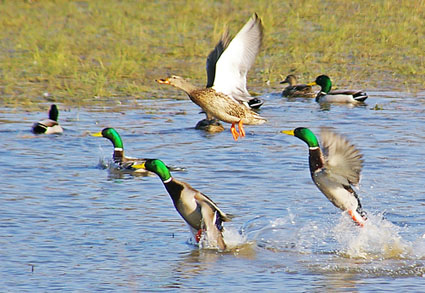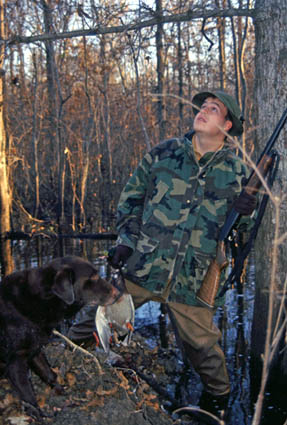 Small waters bodies seldom attract large numbers of ducks but transient birds dropping in for a visit may provide daily shooting opportunities. photo by Keith Sutton |
A friend and I hunted that pothole as teenagers. We placed all four of our duck decoys in the hole. Then we hid in an adjacent thicket and waited for ducks to come.
Often, the ducks would spot us and flare away before entering our limited shooting range. Sometimes, though, the birds drew near, and our shotguns blazed away.
There never were many birds — usually two or three flights during a hunt. Sometimes they were mallards. Other times, teal, shovelers, gadwalls or the occasional prized pintail. We never used a call, but they came anyway. And we kept our families well-fed on waterfowl.
After college, I started hunting ducks seriously, usually in public hunting areas. Unfortunately, many public-lands hunts were marred by continual gunfire, skybusters and other annoyances. I gradually withdrew from the crowds and started looking again for small waters that might lure a few passing birds. Surprisingly, I shot far more ducks on small waters than I did on big public hunting grounds. I enjoyed the hunts again.
Hunting “mud puddle” ducks can be a provocative endeavor, especially for people with limited hunting time and money. Gear shrinks back to a level approaching sanity — just a shotgun, warm clothes, waders and a few decoys. A good retriever is helpful, and you might want to bring a duck call if you can use it. Equipment you don’t need includes large boats, outboard motors, trailers and the dozens of decoys it takes to deploy big-water spreads.
Not all small waters offer good shooting. Of scores of possible locations, only a few appeal to ducks — invariably those with preferred foods.
Wood ducks, for example, are partial to acorns in flooded, timbered bottoms, and sometimes eat button willow and cypress seeds. Mallards prefer acorns, crop grains and seeds of smartweed, wild millet, bulrush, pondweed and button willows. Pintails are grain lovers but often frequent shallow water where seeds of smartweed, pondweed, bulrush, wild millet and burreed are abundant.
Wigeons and gadwalls prefer leaves and stems over seeds. Most frequent small water bodies with beds of pondweed, coontail and/or spike rush. Green-winged teal like to feed on mud flats where they glean seeds of smartweed, millet, bulrush, pondweed, sedge and some grain. Shovelers prefer shallow waters where crayfish, mollusks and insect nymphs are available. Vegetative forage includes seeds of bulrush, pondweed, smartweed and millet.
Where other ducks are common, determine preferred foods, then find hunting areas offering those foods.
 Hunting ducks on small waters often brings satisfaction unavailable on big public hunting areas. photo by Keith Sutton |
Pinpoint several prospective hunting locations, each with different favored forage. This enhances success potential and the variety of birds. One winter I discovered a pond full of coontail that drew several small flocks of gadwalls. A second location was a beaver pond where acorns fell into the water, attracting mallards and wood ducks. A third spot was a mostly drained catfish pond. Invertebrates here attracted flocks of shovelers. By staggering my shooting at these locations, I put ducks on the table all season.
Beaver ponds attract puddle ducks. One good locale is a small creek with beaver ponds strung one after another. Wood ducks, teal, mallards and other ducks will work back and forth over the ponds, especially near dawn and dusk.
Small farm ponds also offer shooting possibilities if you determine how to approach without alerting ducks. If you know birds usually feed on a pond’s shallow end, for example, plan a stealthy approach that puts you within shooting range when ducks flush from that end. If a cold wind is howling, ducks sit on protected sides. In a gentler breeze, they might be on the wind-blown side because the stirring brings food. Scout each locale to determine how best to hunt it.
Some ponds never hold more than two or three birds. A friend told me of hunting one on his property. He hunted 30 minutes each morning before work, then 30 minutes near sunset. “Some visits I wouldn’t see a bird,” he said. “But during the first month, my score was 26 ducks. It was great. I was hunting within 100 yards of my house.”
Small-water duck haunts call for few decoys, if any, and too little calling is preferable to too much. Ducks get suspicious if you get carried away calling, and on calm water, three dozen decoys can look exactly like so many plastic ducks. Make your spread match the waters — small. Use a call if you must, but sparingly.
Blinds are seldom necessary. Small waters are too easy for flying ducks to study in detail, and any built blind arouses suspicion. It’s better to become part of the scene. Wear appropriate camouflage clothing, and move very little. Flop down atop a beaver house, hunker among cattails or stand in tree shadows.
Mud-puddle duck hunts have a unique flavor some hunters find unappealing. For many of us, though, hunting small waters brings satisfaction unavailable elsewhere. There are occasional days when the sound of wings is noticeably absent, but even those times are better than days on public grounds ruined by the skybusting gunnery and other hunters’ inept calling.






